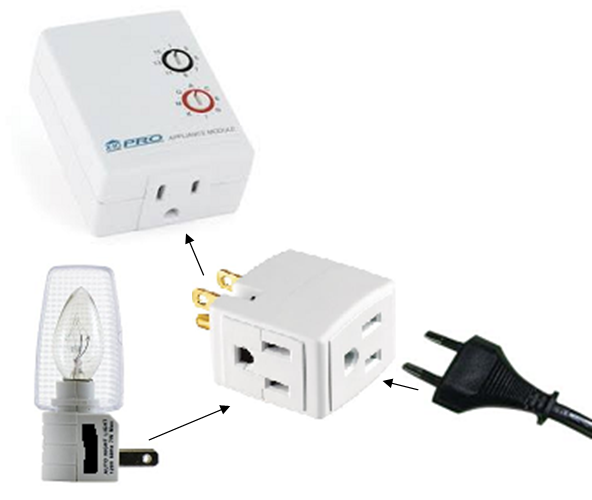Difference between revisions of "Modules Turn On Immediately After Being Turned Off"
X10MichaelC (talk | contribs) |
X10douglas (talk | contribs) |
||
| (13 intermediate revisions by 3 users not shown) | |||
| Line 1: | Line 1: | ||
== Questions == | == Questions == | ||
| − | Why does my Lamp or Appliance Module turn on immediately after being turned off? | + | '''Why does my Lamp or Appliance Module turn on immediately after being turned off?''' |
| + | |||
| + | '''Why does a low-wattage light connected to my Lamp or Appliance Module flicker after being turned off?''' | ||
== Answer == | == Answer == | ||
| − | + | ||
| + | If modules turn ON unpredictably, it is most likely that the modules may have been triggered by a 120V AC power "dip" or "brown out". | ||
| + | |||
| + | X10 Lamp and Appliance Modules have a feature called "'''''local control'''''". This feature lets you turn the X10 module on by turning the physical power switch of the controlled light/appliance off and then on again. | ||
| + | |||
| + | The local control circuit, by design, is very sensitive. False signals can be generated (usually from a dissipating charge), triggering the local control feature and interpreted as a request to turn on. | ||
| + | |||
| + | |||
| + | '''Disabling the Local Control Feature''': | ||
| + | |||
| + | * Plug a [https://www.google.com/search?q=cube+tap&oq=cube+tap&aqs=chrome..69i57j0l5.3320j0j9&sourceid=chrome&es_sm=93&ie=UTF-8 cube tap/plug splitter] into the the X10 module. | ||
| + | |||
| + | * Plug a [https://www.google.com/search?q=cube+tap&oq=cube+tap&aqs=chrome..69i57j0l5.3320j0j9&sourceid=chrome&es_sm=93&ie=UTF-8#q=7%20watt%20night%20light 7 Watt night light] into the same cube tap as the light/appliance you are looking to control. | ||
| + | |||
| + | |||
| + | When the module is ON, the appliance and night light will be ON. When the module is OFF, the appliance and the night light will be OFF. Now, if you operate the power switch on the appliance, the night light is always "in circuit" so the Appliance Module's local control circuit is disabled. | ||
| + | |||
| + | |||
| + | |||
| + | |||
| + | [[Image:Cubetap.png]] | ||
| + | |||
| + | |||
| + | |||
| + | ==Related Articles== | ||
| + | |||
| + | [[Local Control for Lamp And Appliance Modules]] | ||
| + | |||
| + | [[Identifying and Troubleshooting Powerline Noise and Control Problems]] | ||
[[category: Hardware]] | [[category: Hardware]] | ||
Latest revision as of 22:31, 20 May 2014
Questions
Why does my Lamp or Appliance Module turn on immediately after being turned off?
Why does a low-wattage light connected to my Lamp or Appliance Module flicker after being turned off?
Answer
If modules turn ON unpredictably, it is most likely that the modules may have been triggered by a 120V AC power "dip" or "brown out".
X10 Lamp and Appliance Modules have a feature called "local control". This feature lets you turn the X10 module on by turning the physical power switch of the controlled light/appliance off and then on again.
The local control circuit, by design, is very sensitive. False signals can be generated (usually from a dissipating charge), triggering the local control feature and interpreted as a request to turn on.
Disabling the Local Control Feature:
- Plug a cube tap/plug splitter into the the X10 module.
- Plug a 7 Watt night light into the same cube tap as the light/appliance you are looking to control.
When the module is ON, the appliance and night light will be ON. When the module is OFF, the appliance and the night light will be OFF. Now, if you operate the power switch on the appliance, the night light is always "in circuit" so the Appliance Module's local control circuit is disabled.
Related Articles
Local Control for Lamp And Appliance Modules
Identifying and Troubleshooting Powerline Noise and Control Problems
